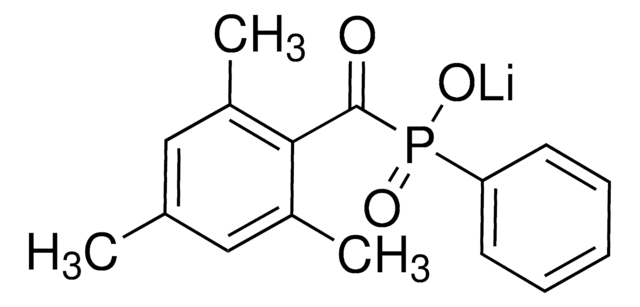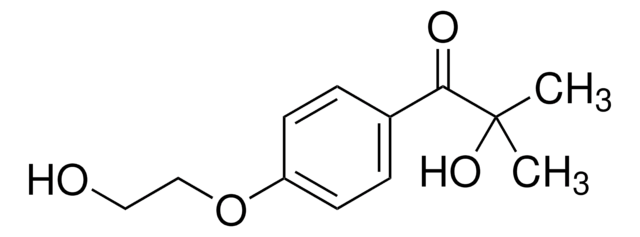915858
Poly(ethylene glycol)-block-poly(propylene glycol)-block-poly(ethylene glycol) diacrylate
average Mn ~5,800
Sinónimos:
PEG-PPG-PEG, Pluronic P-123 diacrylate, Pluronic diacrylate
Iniciar sesiónpara Ver la Fijación de precios por contrato y de la organización
About This Item
Fórmula lineal:
C3H3O[C2H4O]x[C3H6O]y[C2H4O]zC3H3O2
Código UNSPSC:
51171641
NACRES:
NA.23
Productos recomendados
Formulario
solid
Nivel de calidad
mol peso
average Mn ~5,800
color
off-white to yellow
temp. de almacenamiento
−20°C
¿Está buscando productos similares? Visita Guía de comparación de productos
Categorías relacionadas
Aplicación
Poloxamers are nonionic, triblock copolymers containg a central hydrophobic chain of poly(propylene glycol) (PPG) and two terminal hydrophilic chains of poly(ethylene glycol) (PEG). Due to their amphiphilic structure, poloxamer solutions feature temperature dependent self-assembling and thermo-gelling behavior. Concentrated aqueous solutions of poloxamers are liquid at low temperature and form a gel at higher temperature, in a reversible process. This characteristic has allowed for these materials to be used as drug carriers for most routes of administration including oral, topical, intranasal, ocular, and parenteral. Acrylate-modified derivatives are most commonly used as thermosensitive hydrogels for drug delivery and 3D bioprinting applications. After casting or printing, the material can be crosslinked to preserve the hydrogel structure.
Código de clase de almacenamiento
11 - Combustible Solids
Clase de riesgo para el agua (WGK)
WGK 3
Punto de inflamabilidad (°F)
Not applicable
Punto de inflamabilidad (°C)
Not applicable
Elija entre una de las versiones más recientes:
Certificados de análisis (COA)
Lot/Batch Number
¿No ve la versión correcta?
Si necesita una versión concreta, puede buscar un certificado específico por el número de lote.
¿Ya tiene este producto?
Encuentre la documentación para los productos que ha comprado recientemente en la Biblioteca de documentos.
Smart hydrogels for 3D bioprinting
Shuai W, et al.
International Journal of Bioprinting, 1(1), 3-14 (2015)
Self-Assembly of Pluronic F127 Diacrylate in Ethylammonium Nitrate: Structure, Rheology, and Ionic Conductivity before and after Photo-Cross-Linking
Carlos R L, et al.
Macromolecules, 49(14), 5179-5189 (2016)
Photopolymerization of Pluronic F127 diacrylate: a colloid-templated polymerization
Manuela D B, et al.
Soft Materials, 7, 4928-4937 (2011)
J J Escobar-Chávez et al.
Journal of pharmacy & pharmaceutical sciences : a publication of the Canadian Society for Pharmaceutical Sciences, Societe canadienne des sciences pharmaceutiques, 9(3), 339-358 (2007-01-09)
It is, sometimes, desirable to maintain a constant plasma drug concentration within the therapeutically effective concentration range. The use of high viscosity hydromiscible vehicles such as hydrophilic gels, is one of various approaches for controlled drug delivery, and represents an
Christopher J Hansen et al.
Advanced materials (Deerfield Beach, Fla.), 25(1), 96-102 (2012-10-31)
Microvascular multinozzle arrays are designed and fabricated for high-throughput printing of functional materials. Ink-flow uniformity within these multigeneration, bifurcating microchannel arrays is characterized by computer modeling and microscopic particle image velocimetry (micro-PIV) measurements. Both single and dual multinozzle printheads are
Nuestro equipo de científicos tiene experiencia en todas las áreas de investigación: Ciencias de la vida, Ciencia de los materiales, Síntesis química, Cromatografía, Analítica y muchas otras.
Póngase en contacto con el Servicio técnico




